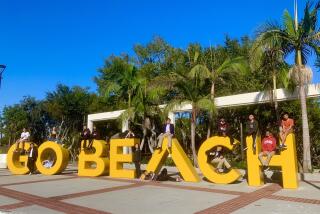A ‘Green’ Challenge for CSUCI
- Share via
Creatively combining academic theory with real-world practicality has been the guiding philosophy of Cal State Channel Islands right from the start. There’s plenty of room for that spirit of innovation in its latest venture.
The CSUCI Site Authority, which serves as landlord and financial manager for the new university, last week approved development of 200 homes on the Camarillo campus.
We encourage the university to design and build these homes with the same environmental consciousness that has guided its transportation planning. Amid the current crisis over electricity supply, what better time and place for a thoughtful display of energy-efficient construction?
The Ventura County satellite campus of Cal State Northridge already is operating at the site, former home of Camarillo State Hospital. If all goes according to plan, by September 2002 it will evolve into Cal State Channel Islands, Ventura County’s first four-year public university, with an eventual enrollment of 15,000 students.
By building on land it already owns, the university expects to turn a profit--thereby fulfilling part of its mandate to pay much of its own way. At the same time, having convenient homes to offer at slightly below-market rates should give administrators an edge in recruiting staff and faculty.
The campus’s isolation from populated areas is both an asset and a challenge. To alleviate traffic and parking congestion, officials have set out to make it a “green” campus by discouraging cars with hefty parking fees and by offering a convenient shuttle bus.
We look for similar efforts at energy efficiency in the new homes. A mix of apartments, townhomes and single-family residences, they are to be part of a development for faculty and staff with a town square, bike and pedestrian paths, a child-care center and an elementary and middle school. Over the next five years, the 150-acre community is expected to have 900 housing units.
The new homes and apartments will have red-tile roofs, shutters and stuccoed walls in harmony with the Spanish Mission-style design of the campus’s original buildings, many of them built more than 60 years ago. We like that nod to the past. Building in state-of-the-art energy efficiency would be a fitting--and cost-effective--nod to the future.
More to Read
Sign up for Essential California
The most important California stories and recommendations in your inbox every morning.
You may occasionally receive promotional content from the Los Angeles Times.













